Part 61: Okinawa: April 14, 1945

Resistance on Okinawa has stiffened now that we've hit the Japanese entrenchment line. The air battle has been surprisingly difficult for us as well. That said, our plan seems to be working so far. Today we'll try to make even more progress.
Allied Turn 4 (USA): April 14, 1945
Cloudy, Dry
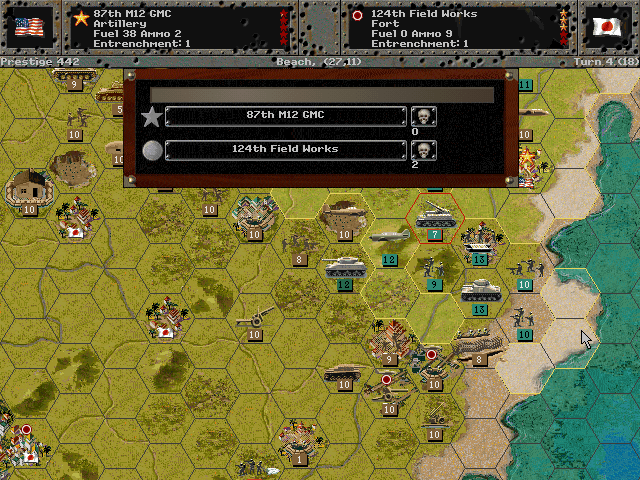
Yonabaru's airfield is a mass of defensive structures. We get to work on softening it up.
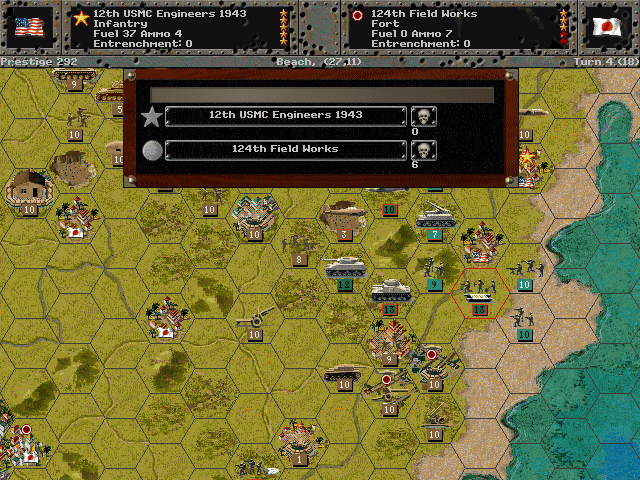
After the barrage, we manage to take out some of the outer field works.
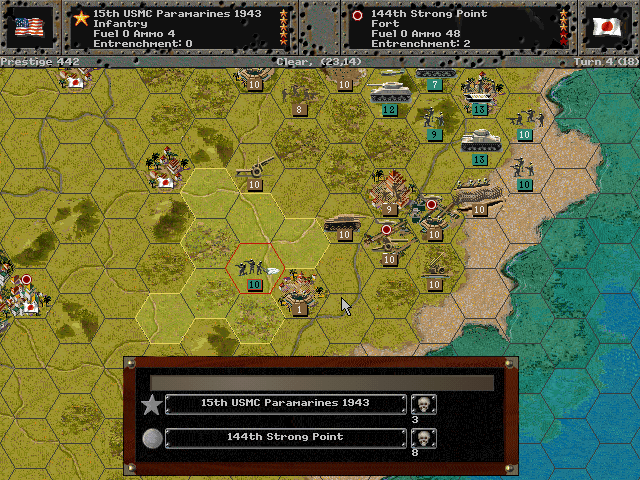
An airborne drop is made to cut off the line of retreat.
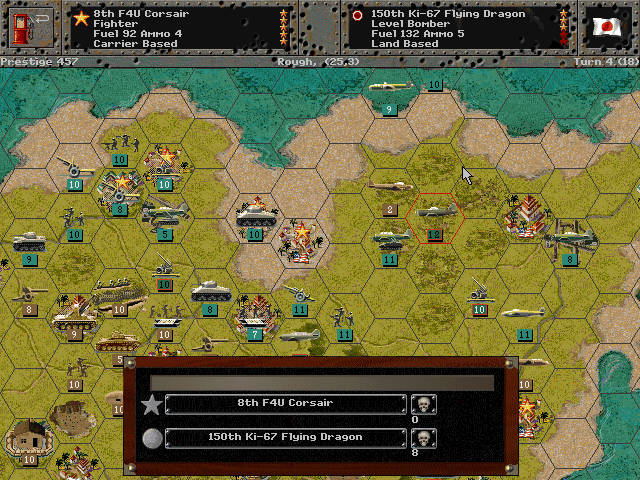
We're starting to win the air battle.
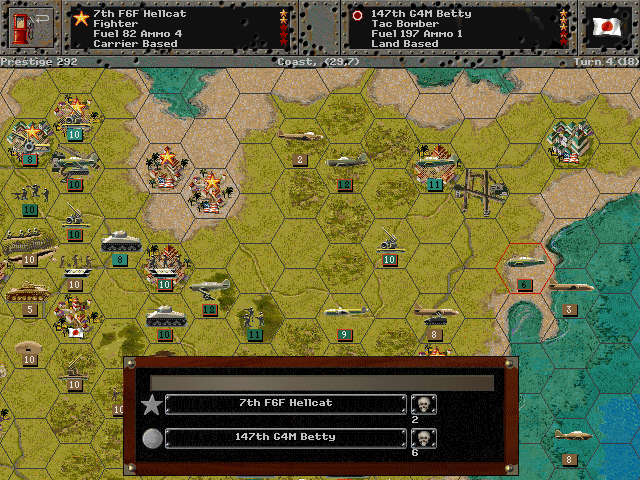
There are a lot of Japanese planes overhead, though.
Axis Turn 4 (Japan): April 14, 1945
Cloudy, Dry
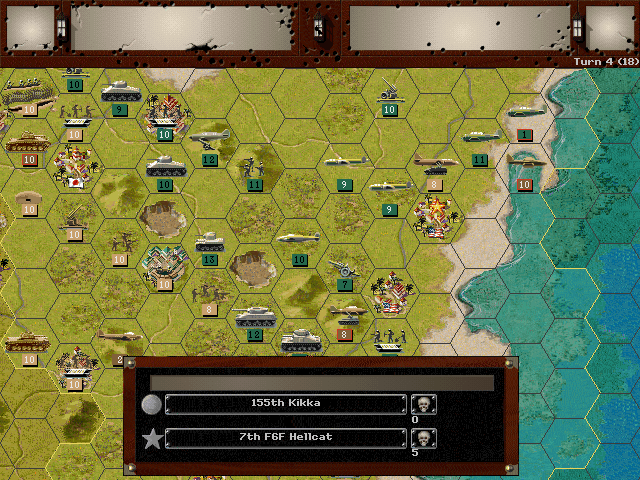
Our least-experienced pilots are in the Hellcats, and they lose in a fight against jet aircraft.
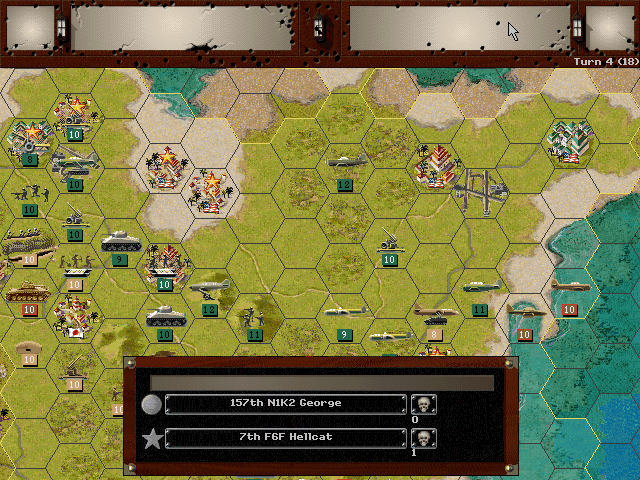
More enemy fighters swoop in to finish them off.
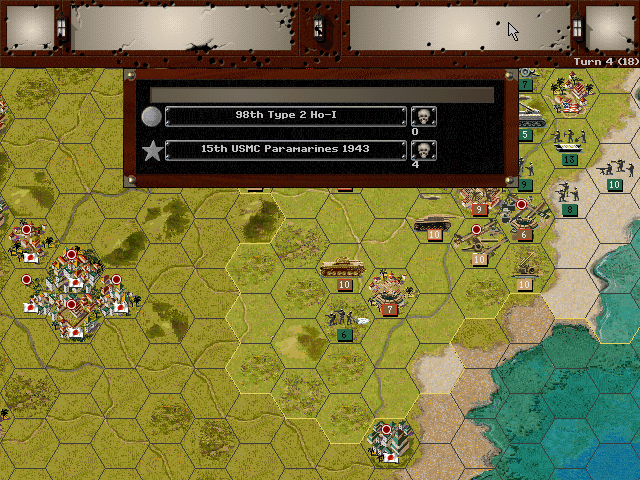
The paramarines attract a lot of attention; they hold their position and keep units from getting to the airfield.
Allied Turn 5 (USA): April 17, 1945
Rain (Dry)
The rain returns and this time we expect it turn the ground muddy.
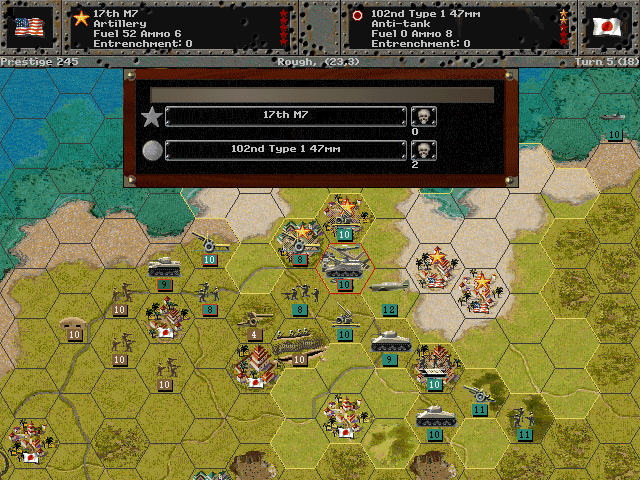
We establish a more comfortable line near Mashiki.
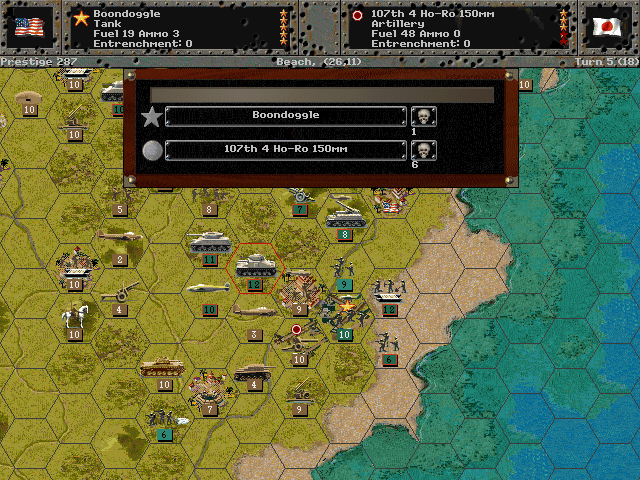
At Yonabaru, we take a portion of the airfield.
Axis Turn 5 (Japan): April 17, 1945
Rain (Dry)
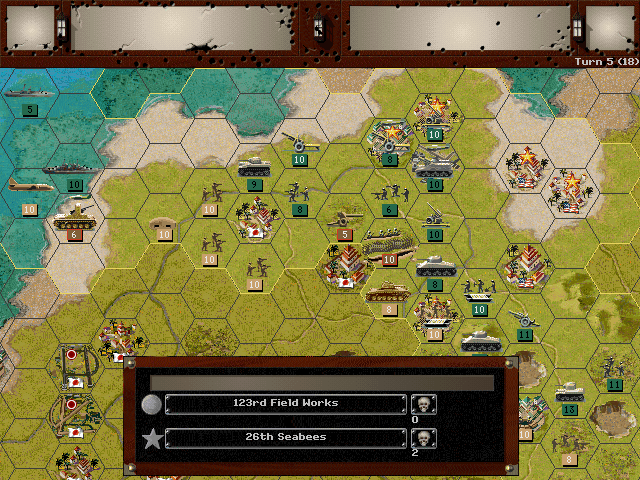
There is a moderate enemy attack along the line at Mashiki.
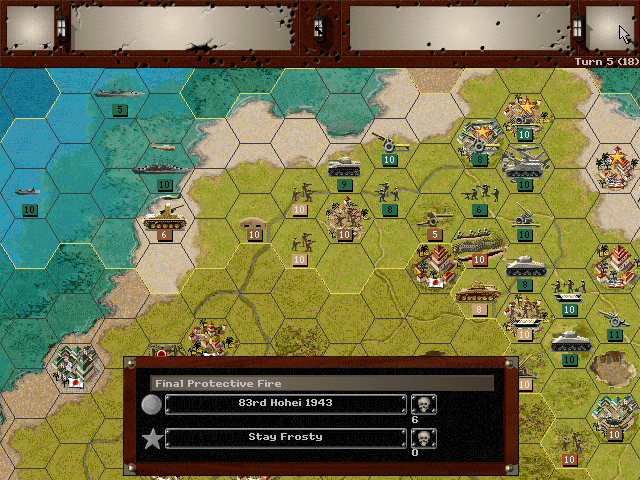
In some places, it goes very poorly for the Japanese.
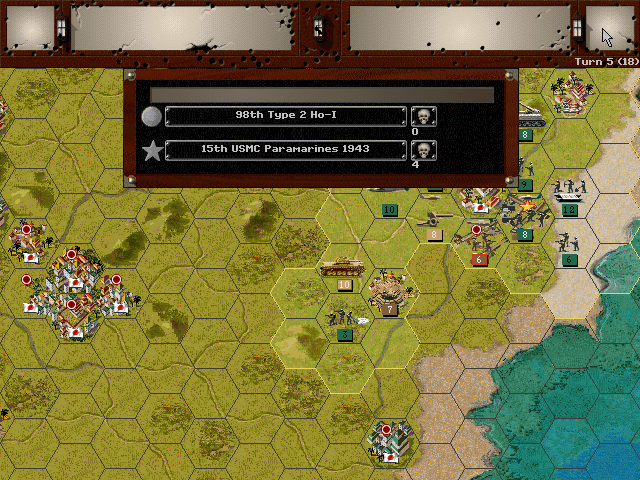
Down near Yonabaru, our marines are in need of rescue now.
Allied Turn 6 (USA): April 20, 1945
Rain (Mud)
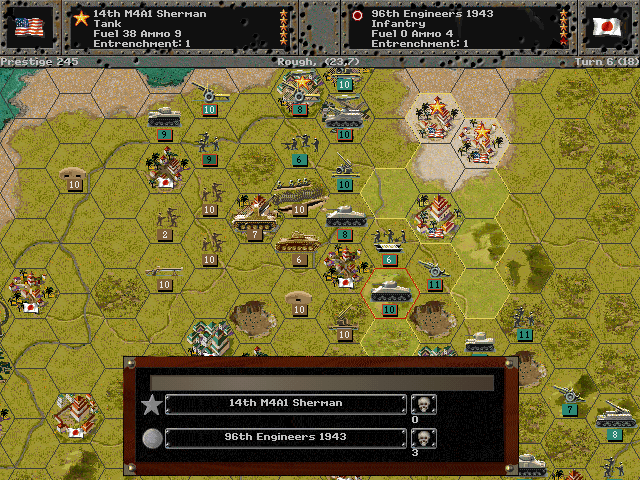
We hold our ground and inflict heavy casualties on the northwestern side.
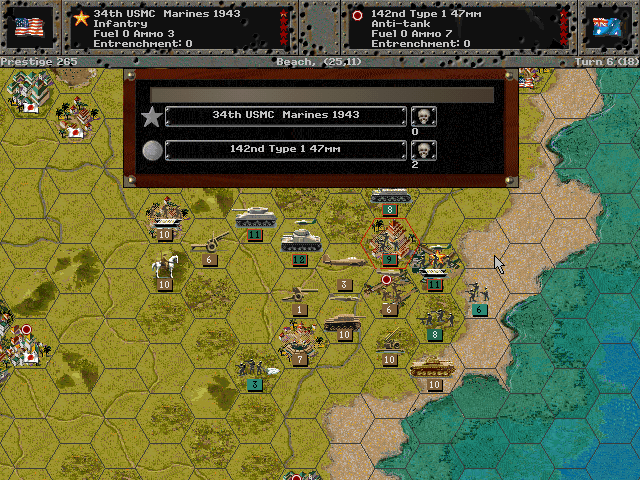
It's a similar situation at Yonabaru; very little progress but the enemy losses are high. They can't hold out for much longer.
Axis Turn 6 (Japan): April 20, 1945
Rain (Mud)

The Japanese exploit a weak point in the line and actually create a bit of a salient, but it costs them dearly to take the position.
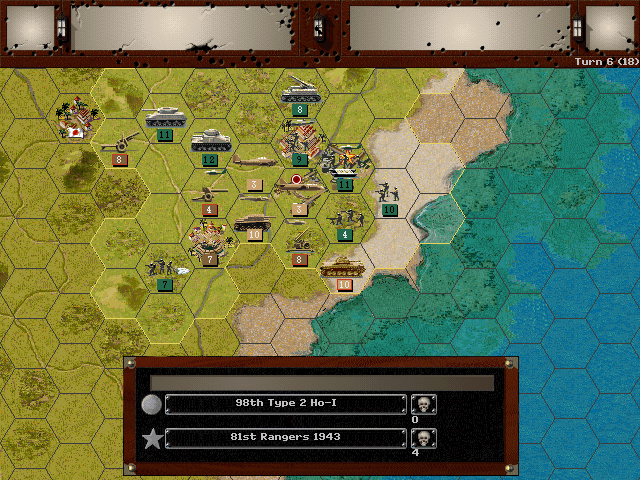
The Army Rangers take heavy losses near Yonabaru.
Allied Turn 7 (USA): April 23, 1945
Cloudy (Mud)
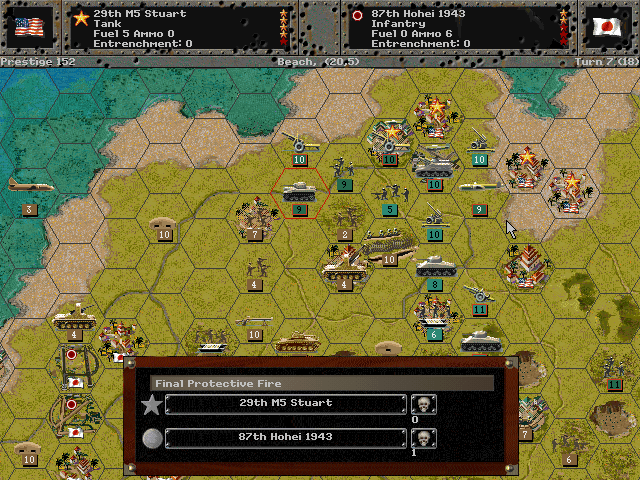
We pull back the line a bit to close the gaps at Mashiki.
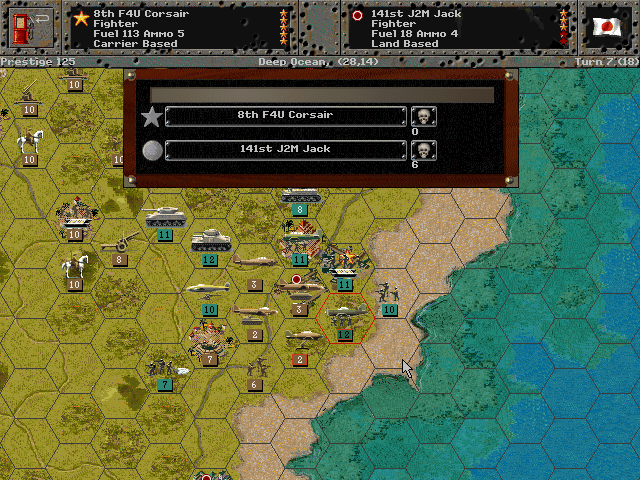
Improved weather lets us send out our squadrons and we down a lot of enemy planes.
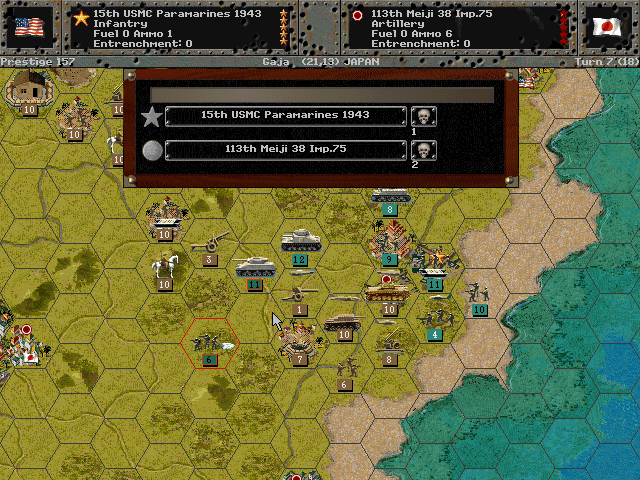
We've managed to barely connect with the paramarines. They may indeed survive.
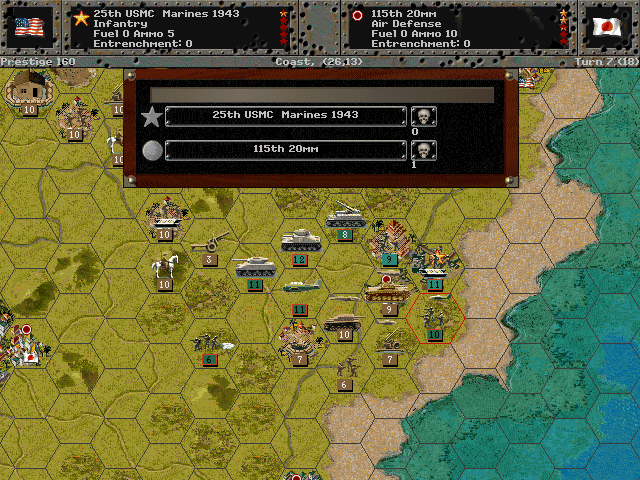
The last few units at the Yonabaru airfield are very entrenched.
Axis Turn 7 (Japan): April 23, 1945
Cloudy (Mud)
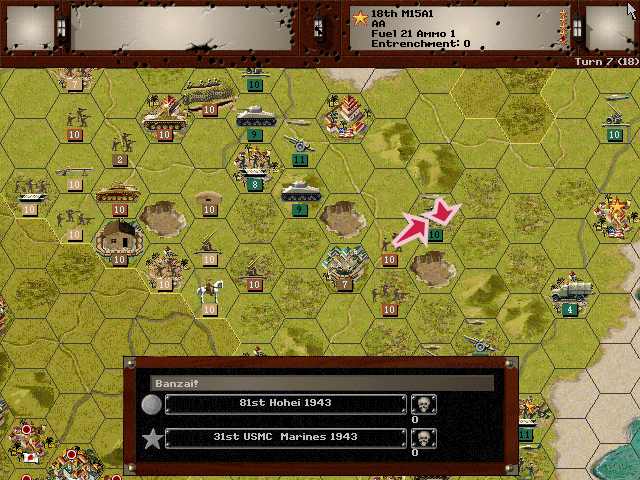
A desperate assault is attempted in the center, but it has no effect.
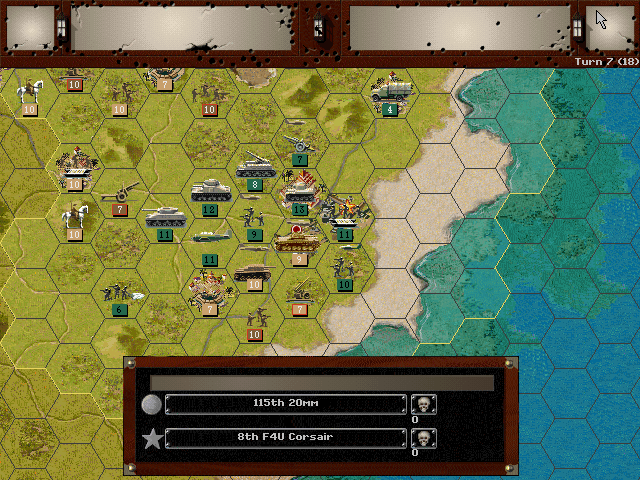
The Japanese flak is similarly ineffective.

Only on the ground, at Yonabaru, is there any bit of success for the Japanese.
Allied Turn 8 (USA): April 26, 1945
Cloudy (Mud) NIGHT
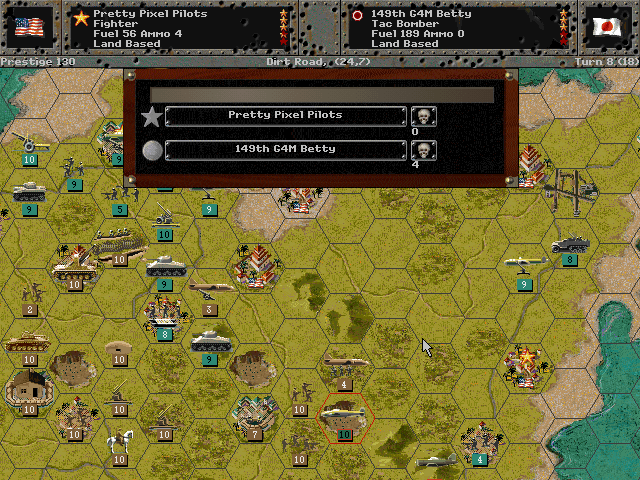
Most of the fighters are gone, so we can work on eliminating the bombers now.
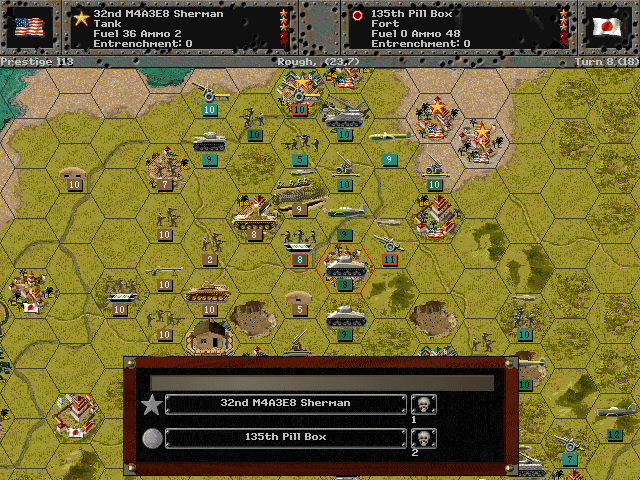
The Japanese line is being squeezed in on Kakazu. We probably need to take that out to get anywhere.
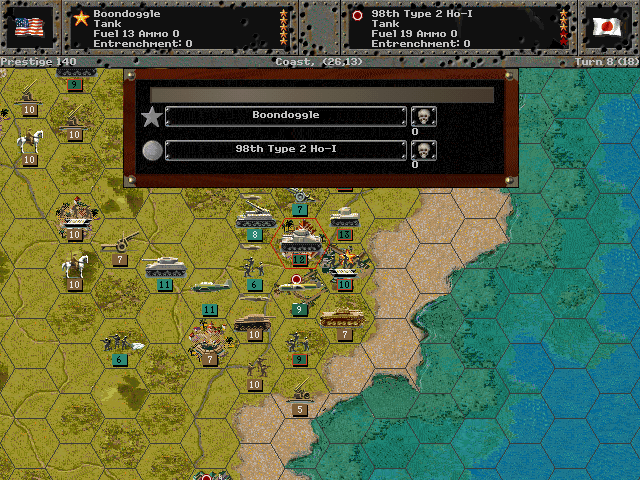
We finally force a retreat at Yonabaru, but our troops are too exhausted to capture the airfield.
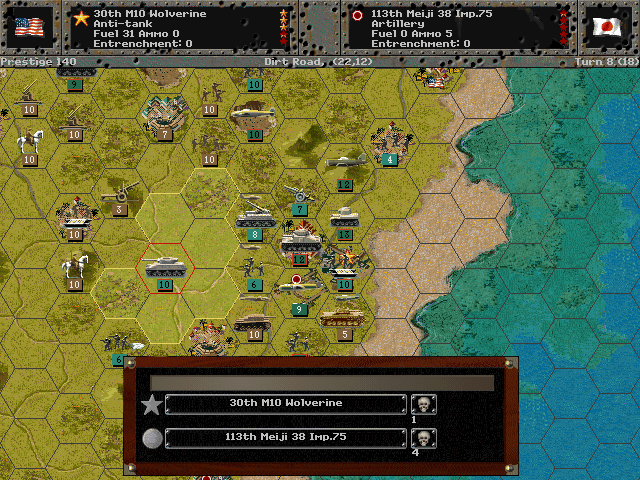
Instead we try to get a start on the push westward.
Axis Turn 8 (Japan): April 26, 1945
Cloudy (Mud)
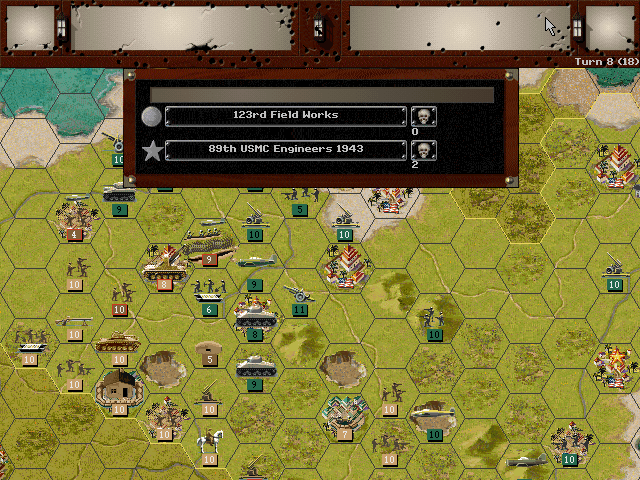
It's pretty clear we can't afford to ignore Kakazu.
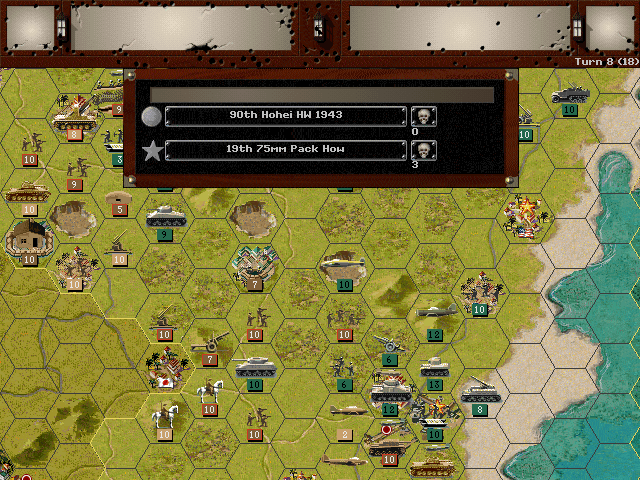
A gap in our lines allows some units to attack our artillery.
Allied Turn 9 (USA): April 29, 1945
Cloudy (Mud)
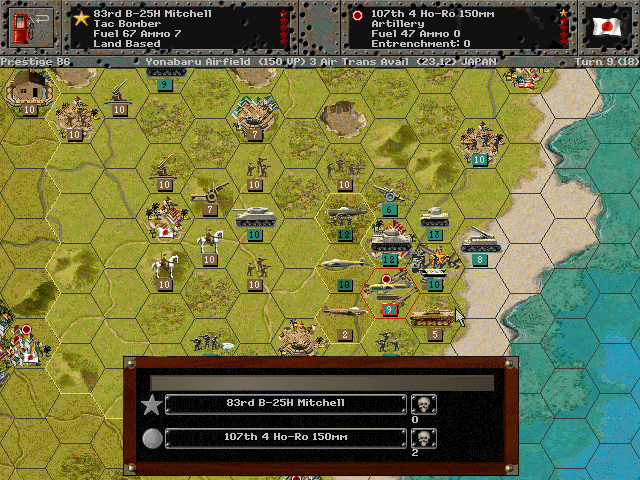
We're finally able to bring our air power to bear.
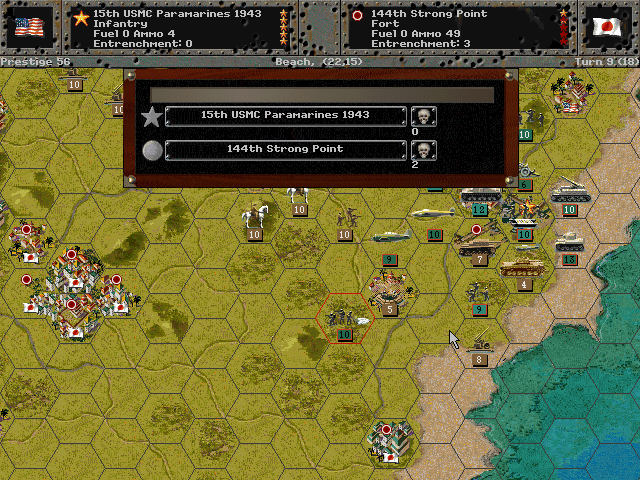
After getting fresh supplies and reinforcements, the paramarines head off on their own to break open the road to Yonabaru village.
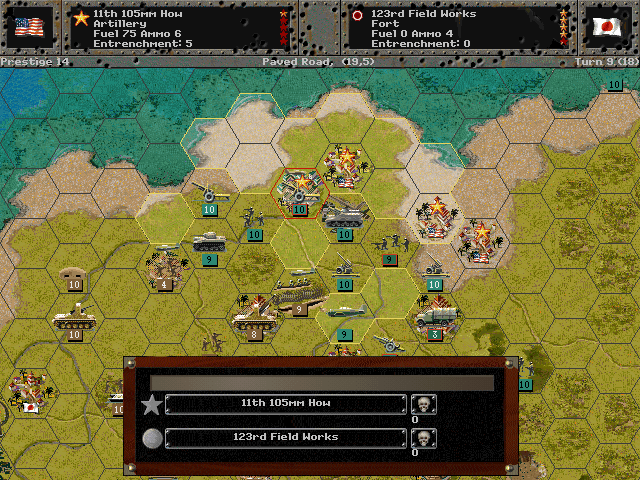
Artillery bombardments aren't achieving much at Kakazu.
Axis Turn 9 (Japan): April 29, 1945
Cloudy, Mud
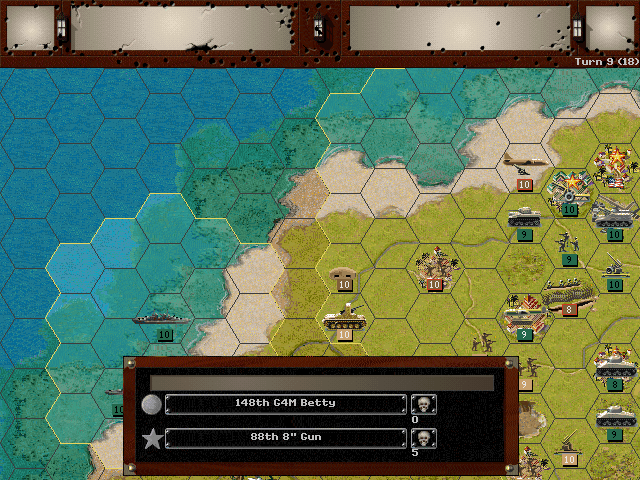
There are some pesky bombers still around.
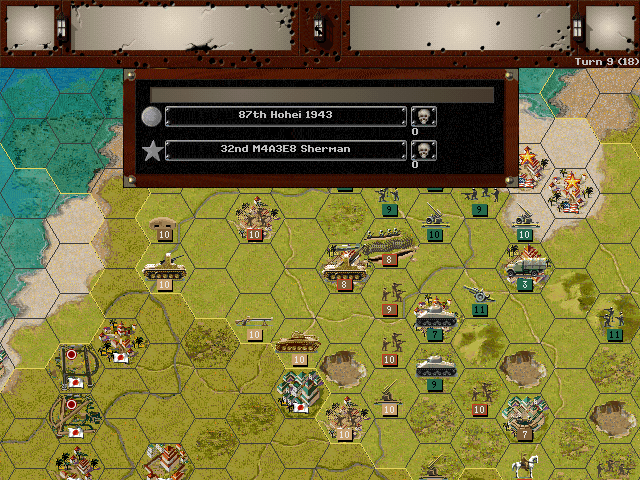
While a lot of troops have come over to engage us, they aren't able to really hurt us.
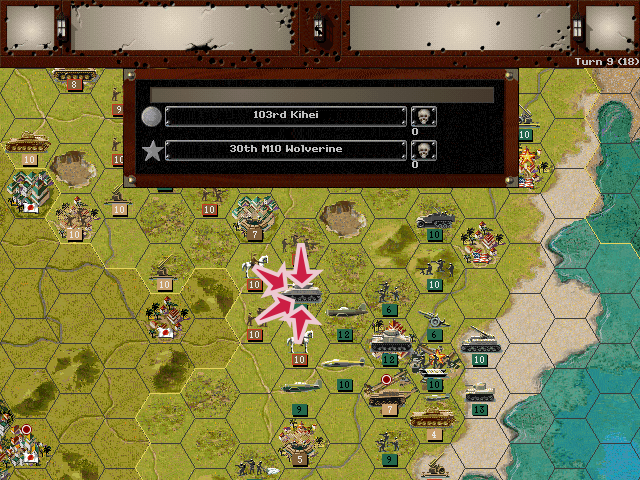
The same thing is happening at Yonabaru, as our anti-tank units hold strong. However, it is making us unable to move out, and causing us to expend supplies at a prodigious rate.
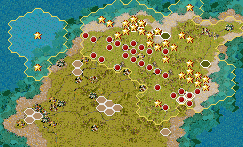
Unit Spotlight
M24 Light Tank 'Chaffee'
PG Name: M24 Chaffee Type: Tank
Effective Date: 12/44
Value:18 Cost:288 Spot:3 Move:7 MM:Track Trans:Naval Fuel: 41
Init:9 SA:11 HA:12 AA:[2] NA:1 GD:10 AD:3 CD:3 TT:Hard Ammo:7
The M3 and M5 were put into production as quickly as possible, even though their design flaws were very apparent. Almost immediately an entirely new design was created to improve on the light tank concept. Incorporating a powerful 75mm gun and better construction and armor than the previous models, the M24 became the obvious replacement for the Stuart.
These ended up being the most common tanks used during the occupation of Japan after the war, as their relatively light weight made them able to travel roads that the heavier models could not. They continued to see use into the Korean War and even as late as Vietnam.
In-game analysis: Cheaper than an M4, but just as combat-capable, this model is the clear choice if that's all the power you need. While it wouldn't be worth an upgrade, it's the best value for a new tank in the final year of the war, especially against a Japanese opponent.
Alaska-class Heavy Cruiser [Battlecruiser] (2 of 6 built)
PG Name: Alaska Type:Battleship
Effective Date: 3/43
Value:35 Cost:810 Spot:2 Move:5 MM:Deep Naval Fuel: 76
Init:5 Range:5 SA:7 HA:10 AA:19 NA:18 DA:0 GD:18 AD:7 TD:10 TT:N/A Ammo:40
Special: Radar
Since the breakout of war rendered treaty agreements on ship size moot, unrestrained cruiser plans was revived in the US. At over 27,000 tons displacement, the Alaska-class was far larger than normal cruisers, and comparable to small battleships of the previous generation. They carried battlecruiser-size 12" guns, and were very thinly armored (especially against torpedoes), but also fairly quick. There did not seem to be a real role for them in the fleet of the era. While widely criticized as unnecessary, two ships were nevertheless completed.
In-game Analysis: This isn't so much a battleship/battlecruiser as it is a sea-going anti-aircraft platform. It is best suited as an escort for a carrier, but can also fight like a heavy cruiser, making it an odd duck. If you have a slot open, a ton of prestige to spend, and are concerned about protection from air attacks while also wanting the power of a cruiser, maybe go for it, but it's probably not a necessary item. There is a much cheaper AA ship that arrives in 1944, and cruisers do not need to cost this much.
Northrop P-61 Black Widow
PG Name: P-61 Black Widow Type:Fighter
Effective Date: 7/44
Value:51 Cost:612 Spot:3 Move:10 MM:Air Fuel: 178
Init:5 SA:5 HA:4 AA:22 NA:0 GD:13 AD:20 TT:No Ammo:4
Special: Radar
The P-61 was the first US plane designed specifically for night fighting. With a crew of three, twin-engined design, and even a dorsal turret, it resembled a bomber a bit more than a fighter, and in fact the second variant could carry a bomb load equivalent to that of some bombers. It was able to perform well in the air mostly due to its deadly array of four 20mm cannons and a decent top speed (improved in the final variant). The ability to find its targets in the night with the onboard radar was another point in its favor. While originally meant for the British, delays in testing the radar made it a late arrival to the war; the British for their part preferred their own Mosquito as a night fighter anyway.
In-game Analysis: This is very expensive (the first plane to break the 600-prestige price mark), but you do get a deadly machine for that price. Probably its only downside is the relatively low amount of ammo. In the wrong situation that can make a crucial difference, and I'm not sure I'd want to risk losing such a valuable unit by having it be picked apart by a swarm of cheaper enemy fighters. With experienced pilots and a close watch on ammo consumption, I doubt that it could ever be shot down.